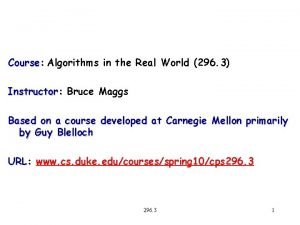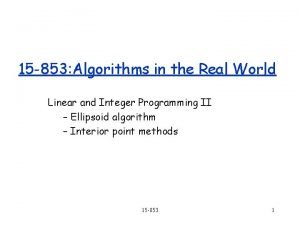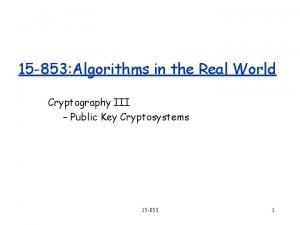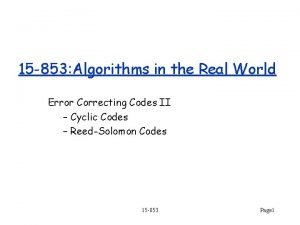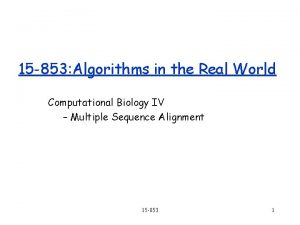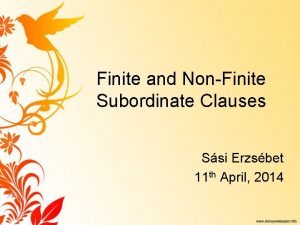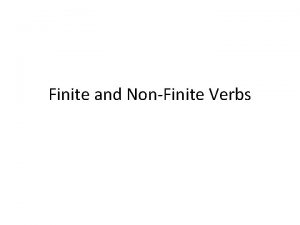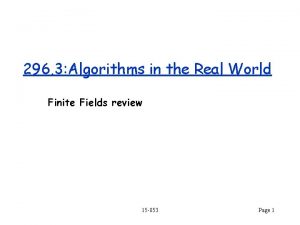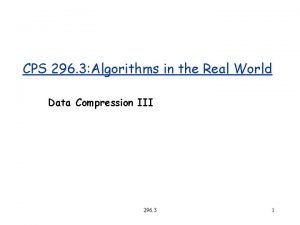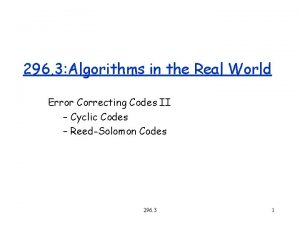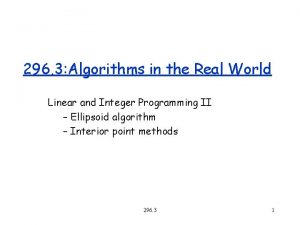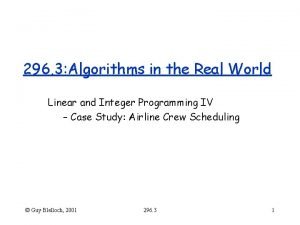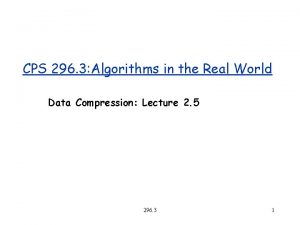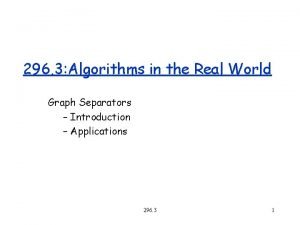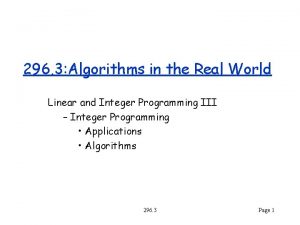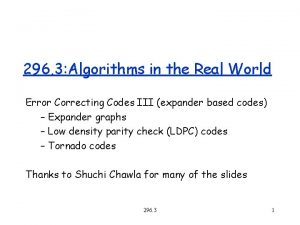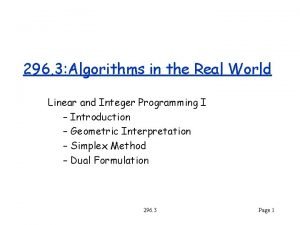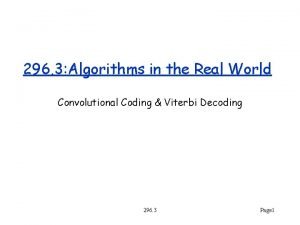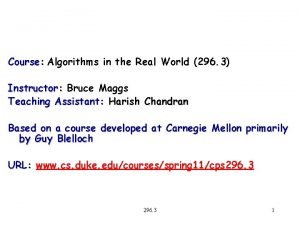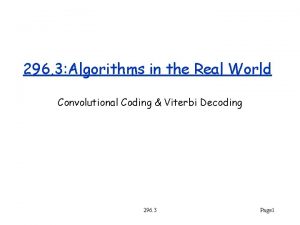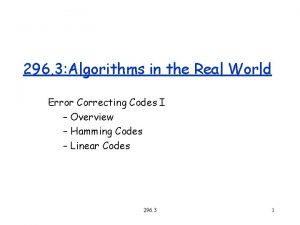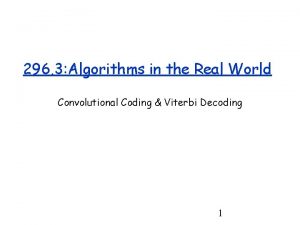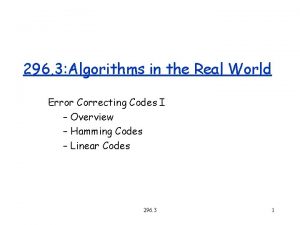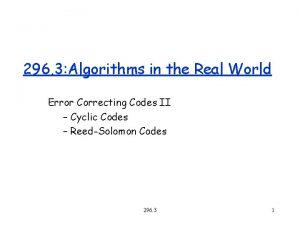296 3 Algorithms in the Real World Finite









![Polynomials over Zp Zp[x] = polynomials on x with coefficients in Zp. – Example Polynomials over Zp Zp[x] = polynomials on x with coefficients in Zp. – Example](https://slidetodoc.com/presentation_image/38b1d1984a0ed1aa26d0ff5fa18cef1e/image-10.jpg)
![Division and Modulus Long division on polynomials (Z 5[x]): with remainder 15 -853 Page Division and Modulus Long division on polynomials (Z 5[x]): with remainder 15 -853 Page](https://slidetodoc.com/presentation_image/38b1d1984a0ed1aa26d0ff5fa18cef1e/image-11.jpg)

![Galois Fields The polynomials Zp[x] mod p(x) where p(x) Zp[x], p(x) is irreducible, and Galois Fields The polynomials Zp[x] mod p(x) where p(x) Zp[x], p(x) is irreducible, and](https://slidetodoc.com/presentation_image/38b1d1984a0ed1aa26d0ff5fa18cef1e/image-13.jpg)






- Slides: 19

296. 3: Algorithms in the Real World Finite Fields review 15 -853 Page 1

Finite Fields Outline Groups – Definitions, Examples, Properties – Multiplicative group modulo n Fields – Definition, Examples – Polynomials – Galois Fields Why review finite fields? 15 -853 Page 2

Groups A Group (G, *, I) is a set G with operator * such that: 1. Closure. For all a, b G, a * b G 2. Associativity. For all a, b, c G, a*(b*c) = (a*b)*c 3. Identity. There exists I G, such that for all a G, a*I=I*a=a 4. Inverse. For every a G, there exist a unique element b G, such that a*b=b*a=I An Abelian or Commutative Group is a Group with the additional condition 5. Commutativity. For all a, b G, a*b=b*a 15 -853 Page 3

Examples of groups – Integers, Reals or Rationals with Addition – The nonzero Reals or Rationals with Multiplication – Non-singular n x n real matrices with Matrix Multiplication – Permutations over n elements with composition [0 1, 1 2, 2 0] o [0 1, 1 0, 2 2] = [0 0, 1 2, 2 1] We will only be concerned with finite groups , I. e. , ones with a finite number of elements. 15 -853 Page 4

Key properties of finite groups Notation: aj a * a * … j-1 instances of * Theorem (from La. Grange’s Theorem): for any finite group (G, *, I) and g G, g|G| = I Fermat’s Little Theorem (special case): gp-1 = 1 mod p Definition : the order of g G is the smallest positive integer m such that gm = I Definition: a group G is cyclic if there is a g G such that order(g) = |G| Definition: an element g G of order |G| is called a generator or primitive element of G. 15 -853 Page 5

Groups based on modular arithmetic The group of positive integers modulo a prime p Zp* {1, 2, 3, …, p-1} *p multiplication modulo p Denoted as: (Zp*, *p) Required properties 1. Closure. Yes. 2. Associativity. Yes. 3. Identity. 1. 4. Inverse. Yes. Example: Z 7*= {1, 2, 3, 4, 5, 6} 1 -1 = 1, 2 -1 = 4, 3 -1 = 5, 6 -1 = 6 15 -853 Page 6

Other properties |Zp*| = (p-1) By Fermat’s little theorem: a(p-1) = 1 (mod p) Example of Z 7* Generators x 1 2 3 4 5 6 x 2 1 4 2 2 4 1 x 3 1 1 6 6 x 4 1 2 4 4 2 1 x 5 1 4 5 2 3 6 x 6 1 1 1 For all p the group is cyclic. 15 -853 Page 7

Fields A Field is a set of elements F with binary operators * and + such that 1. (F, +) is an abelian group 2. (F I+, *) is an abelian group the “multiplicative group” 3. Distribution : a*(b+c) = a*b + a*c 4. Cancellation : a*I+ = I+ The order of a field is the number of elements. A field of finite order is a finite field. The reals and rationals with + and * are fields. 15 -853 Page 8

Finite Fields Zp (p prime) with + and * mod p, is a finite field. 1. (Zp, +) is an abelian group (0 is identity) 2. (Zp 0, *) is an abelian group (1 is identity) 3. Distribution : a*(b+c) = a*b + a*c 4. Cancellation : a*0 = 0 Are there other finite fields? What about ones that fit nicely into bits, bytes and words (i. e. , with 2 k elements)? 15 -853 Page 9
![Polynomials over Zp Zpx polynomials on x with coefficients in Zp Example Polynomials over Zp Zp[x] = polynomials on x with coefficients in Zp. – Example](https://slidetodoc.com/presentation_image/38b1d1984a0ed1aa26d0ff5fa18cef1e/image-10.jpg)
Polynomials over Zp Zp[x] = polynomials on x with coefficients in Zp. – Example of Z 5[x]: f(x) = 3 x 4 + 1 x 3 + 4 x 2 + 3 – deg(f(x)) = 4 (the degree of the polynomial) Operations: (examples over Z 5[x]) • Addition: (x 3 + 4 x 2 + 3) + (3 x 2 + 1) = (x 3 + 2 x 2 + 4) • Multiplication: (x 3 + 3) * (3 x 2 + 1) = 3 x 5 + x 3 + 4 x 2 + 3 • I+ = 0, I* = 1 • + and * are associative and commutative • Multiplication distributes and 0 cancels Do these polynomials form a field? 15 -853 Page 10
![Division and Modulus Long division on polynomials Z 5x with remainder 15 853 Page Division and Modulus Long division on polynomials (Z 5[x]): with remainder 15 -853 Page](https://slidetodoc.com/presentation_image/38b1d1984a0ed1aa26d0ff5fa18cef1e/image-11.jpg)
Division and Modulus Long division on polynomials (Z 5[x]): with remainder 15 -853 Page 11

Polynomials modulo Polynomials How about making a field of polynomials modulo another polynomial? This is analogous to Zp (i. e. , integers modulo another integer). e. g. , Z 5[x] mod (x 2+2 x+1) Does this work? Problem: (x+1) = 0 Multiplication not closed over non-zero polynomials! Definition: An irreducible polynomial is one that is not a product of two other polynomials both of degree greater than 0. e. g. , (x 2 + 2) for Z 5[x] Analogous to a prime number. 15 -853 Page 12
![Galois Fields The polynomials Zpx mod px where px Zpx px is irreducible and Galois Fields The polynomials Zp[x] mod p(x) where p(x) Zp[x], p(x) is irreducible, and](https://slidetodoc.com/presentation_image/38b1d1984a0ed1aa26d0ff5fa18cef1e/image-13.jpg)
Galois Fields The polynomials Zp[x] mod p(x) where p(x) Zp[x], p(x) is irreducible, and deg(p(x)) = n (i. e. , n+1 coefficients) form a finite field. Such a field has pn elements. These fields are called Galois Fields or GF(p n). The special case n = 1 reduces to the fields Zp The multiplicative group of GF(pn)/{0} is cyclic (this will be important later). 15 -853 Page 13

GF(2 n) Hugely practical! The coefficients are bits {0, 1}. For example, the elements of GF(28) can be represented as a byte, one bit for each term, and GF(264) as a 64 -bit word. – e. g. , x 6 + x 4 + x + 1 = 01010011 How do we do addition? Addition over Z 2 corresponds to xor. • Just take the xor of the bit-strings (bytes or words in practice). This is dirt cheap 15 -853 Page 14

Multiplication over GF(2 n) If n is small enough can use a table of all combinations. The size will be 2 n x 2 n (e. g. 64 K for GF(28)). Otherwise, use standard shift and add (xor) Note: dividing through by the irreducible polynomial on an overflow by 1 term is simply a test and an xor. e. g. 0111 / 1001 = 0111 1011 / 1001 = 1011 xor 1001 = 0010 ^ just look at this bit for GF(23) 15 -853 Page 15

Multiplication over GF(28) typedef unsigned char uc; uc mult(uc a, uc b) { int p = a; uc r = 0; while(b) { if (b & 1) r = r ^ p; b = b >> 1; p = p << 1; if (p & 0 x 100) p = p ^ 0 x 11 B; } return r; } 15 -853 Page 16

Finding inverses over GF(2 n) Again, if n is small just store in a table. – Table size is just 2 n. For larger n, use Euclid’s algorithm. – This is again easy to do with shift and xors. 15 -853 Page 17

Polynomials with coefficients in GF(pn) Recall that GF(pn) were defined in terms of coefficients that were themselves fields (i. e. , Zp). We can apply this recursively and define: GF(p n)[x] = polynomials on x with coefficients in GF(pn). – Example of GF(23)[x]: f(x) = 001 x 2 + 101 x + 010 Where 101 is shorthand for x 2+1. 15 -853 Page 18

Polynomials with coefficients in GF(pn) We can make a finite field by using an irreducible polynomial M(x) selected from GF(pn)[x]. For an order m polynomial and by abuse of notation we write: GF(GF(p n)m), which has pnm elements. Used in Reed-Solomon codes and Rijndael. – In Rijndael p=2, n=8, m=4, i. e. each coefficient is a byte, and each element is a 4 byte word (32 bits). Note: all finite fields are isomorphic to GF(pn), so this is really just another representation of GF(232). This representation, however, has practical advantages. 15 -853 Page 19
 Algorithms in the real world
Algorithms in the real world 15-853 algorithms in the real world
15-853 algorithms in the real world 15-853 algorithms in the real world
15-853 algorithms in the real world 15-853 algorithms in the real world
15-853 algorithms in the real world Xv-853
Xv-853 15-853 algorithms in the real world
15-853 algorithms in the real world Finite subordinate clauses
Finite subordinate clauses What is finite verb
What is finite verb Learning objectives of non finite verbs
Learning objectives of non finite verbs Finite and nonfinite verbs
Finite and nonfinite verbs Non finite forms of the verb qayda
Non finite forms of the verb qayda Real life application of polynomial
Real life application of polynomial Real world vs digital world
Real world vs digital world Plato example
Plato example Wac 296 305
Wac 296 305 Wac 296-800-160
Wac 296-800-160 Wac 296 305
Wac 296 305 Nnpj-296
Nnpj-296 Sos mihai bravu 296
Sos mihai bravu 296 Wac 296 305
Wac 296 305
